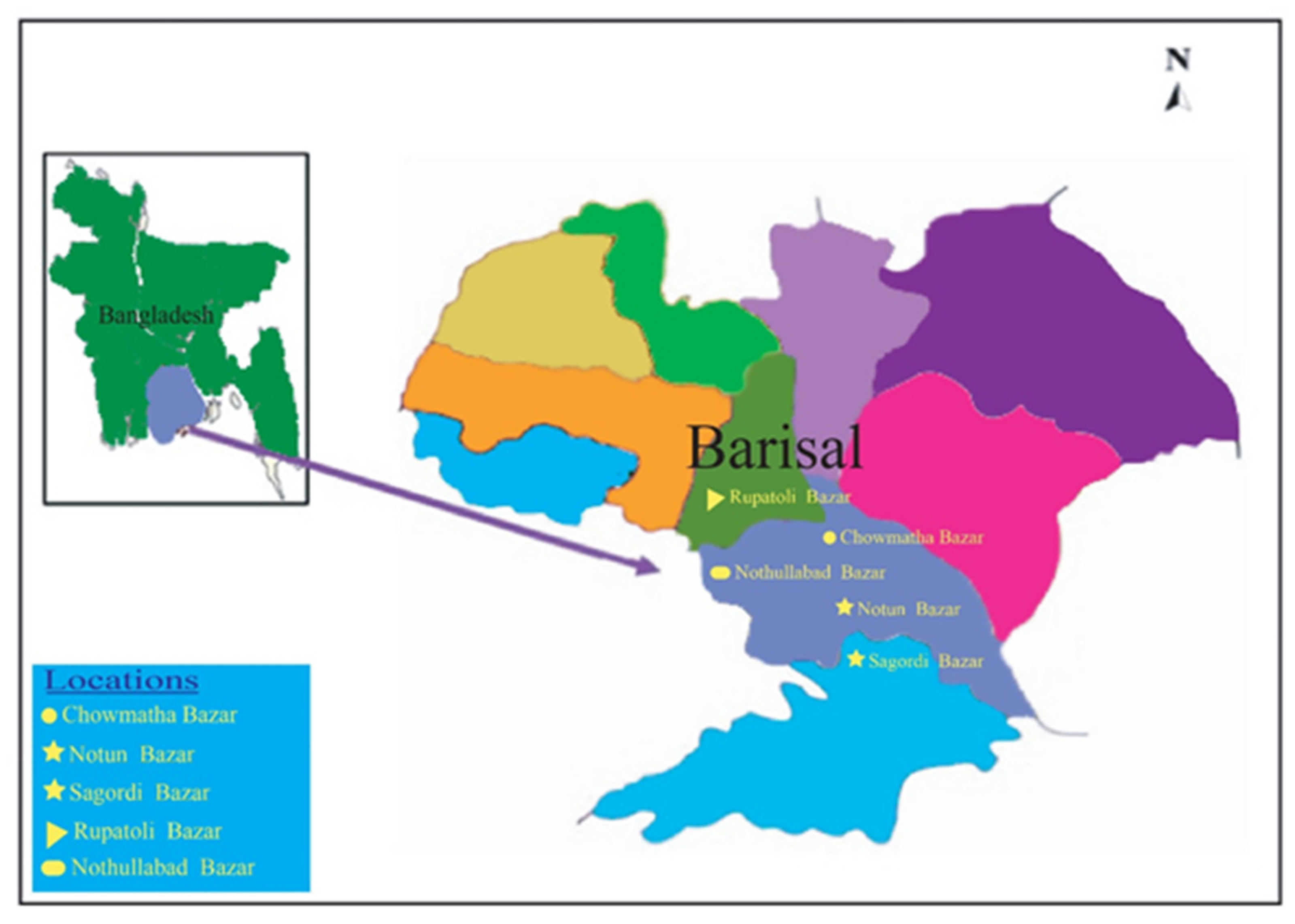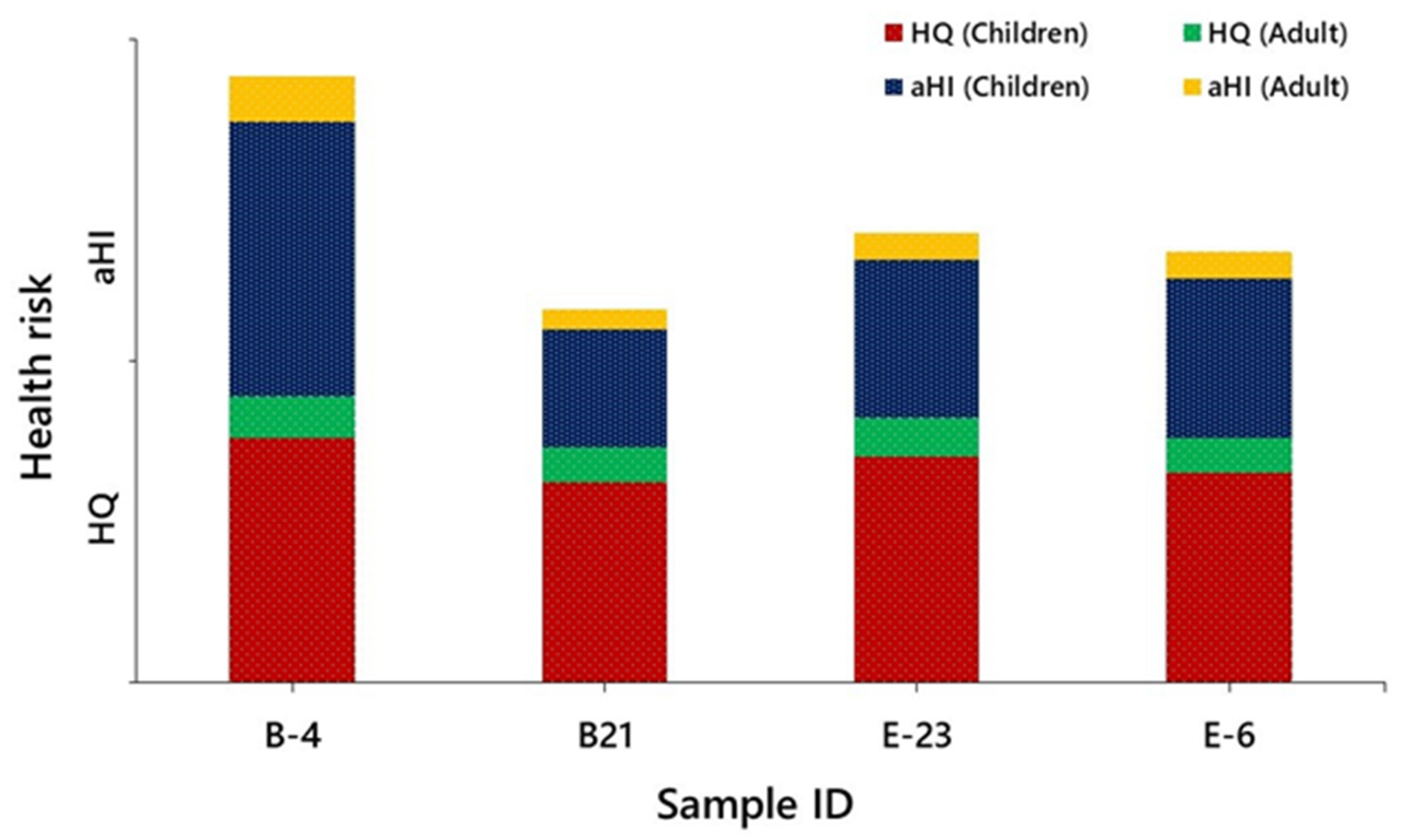Quantification of Pesticide Residues in Fresh Vegetables Available in Local Markets for Human Consumption and the Associated Health Risks
Abstract
1. Introduction
2. Materials and Methods
2.1. Sample Collection and Preparation
2.2. Chemicals and Reagents
2.3. Preparation of Pesticide Standard Solution
2.4. Extraction and Clean Up
2.5. Instrumental Analysis
2.6. Quality Assurance Procedure
2.7. Health Risk Assessment
2.8. Statistical Analysis
3. Results and Discussion
3.1. Pesticide Residues in Country Bean
3.2. Pesticide Residues in Eggplant
3.3. Human Health Risk Assessment
4. Conclusions
Supplementary Materials
Author Contributions
Funding
Acknowledgments
Conflicts of Interest
References
- Kumari, B.; Madan, V.; Kumar, R.; Kathpal, T. Monitoring of seasonal vegetables for pesticide residues. Environ. Monit. Assess. 2002, 74, 263–270. [Google Scholar] [CrossRef] [PubMed]
- Miah, M.; Barman, N.; Alam, M.; Yesmin, K.; Ahmad, M. Effectiveness of some IPM packages consisting of chemical and non chemical components for suppressing pod borer and aphid in summer country bean. J. Environ. Sci. Nat. Resour. 2017, 10, 109–115. [Google Scholar] [CrossRef]
- Jadhav, B.; Patil, B.; Patil, V. Effects of triacontanol on lablab-bean and Indian mustard. Ind. J. Agric. Sci. 1987, 57, 56–58. [Google Scholar]
- Parven, A.; Khan, M.S.I.; Prodhan, M.D.H.; Venkateswarlu, K.; Mallavarapu, M.; Islam, M. Human health risk assessment through quantitative screening of insecticide residues in two green beans to ensure food safety. J. Food Compos. Anal. 2021, 104121. [Google Scholar] [CrossRef]
- Rashid, M.; Hasan, M.; Matin, M. Socio-economic performance of BT eggplant cultivation in Bangladesh. Bangladesh J. Agric. Res. 2018, 43, 187–203. [Google Scholar] [CrossRef]
- Kumar, G.; Meena, B.; Kar, R.; Tiwari, S.K.; Gangopadhyay, K.; Bisht, I.; Mahajan, R. Morphological diversity in brinjal (Solanum melongena L.) germplasm accessions. Plant Gen. Resour. 2008, 6, 232. [Google Scholar] [CrossRef]
- Aktar, M.A.; Khatun, R.; Prodhan, M.D.H. Determination of pesticide residues in eggplant using modified quechers extraction and gas chromatography. Int. J. Agron. Agric. Res. 2017, 11, 22–31. [Google Scholar]
- Meftaul, I.M.; Venkateswarlu, K.; Dharmarajan, R.; Annamalai, P.; Megharaj, M. Pesticides in the urban environment: A potential threat that knocks at the door. Sci. Total Environ. 2020, 711, 134612. [Google Scholar] [CrossRef]
- Meftaul, I.M.; Venkateswarlu, K.; Dharmarajan, R.; Annamalai, P.; Asaduzzaman, M.; Parven, A.; Megharaj, M. Controversies over human health and ecological impacts of glyphosate: Is it to be banned in modern agriculture? Environ. Pollut. 2020, 263, 114372. [Google Scholar] [CrossRef]
- Meftaul, M.I.; Venkateswarlu, K.; Rajarathnam, D.; Annamalai, P.; Megharaj, M. Sorption‒desorption of dimethoate in urban soils and potential environmental impacts. Environ. Sci Process. Impacts 2020, 22, 2256–2265. [Google Scholar] [CrossRef]
- Begum, A.; Akon, M.W.; Ahmed, M.S.; Alam, S.N. Purity analysis of nine pesticides collected from eight locations in Bangladesh. Bangladesh J. Agric. Res. 2016, 41, 685–694. [Google Scholar] [CrossRef][Green Version]
- Ahmed, M.S.; Sarder, M.; Hoque, M.; Kabir, K. A survey on the pattern of insecticidal usage for the protection of the brinjal (Solanum melongina L.) from the attack of insect pests in Jessore. Bangladesh J. Zool. 2005, 33, 57. [Google Scholar]
- Kabir, K.; Baksh, M.; Rouf, F.; Karim, M.; Ahmed, A. Insecticide usage pattern on vegetables at farmers’ level of jessore region in Bangladesh: A survey finding. Bangladesh J. Agric. Res. 1996, 21, 241–254. [Google Scholar]
- Ahmed, M.S.; Sardar, M.M.A.; Ahmad, M.; Kabir, K.H. Quantification of purity of some frequently used insecticides in vegetables insect pests. Asian J. Med. Biol. Res. 2017, 3, 267–275. [Google Scholar] [CrossRef][Green Version]
- Afroze, M.; Prodhan, M.D.H.; Begum, A.; Ahmed, M.S.; Sarker, D. Purity Analysis of Different Brands of Marketed Pesticides. 2020. Available online: https://www.Researchgate.Net/publication/347974924 (accessed on 25 January 2021).
- Chowdhury, M.A.; Hasan, M.S. Hand book of agricultural technology. In Bangladesh Agricultural Research Council & Asian Food and Agriculture Cooperation Initiative; Bangladesh Agricultural Research Council: Dhaka, Bangladesh, 2013; pp. 74–92. [Google Scholar]
- Chowdhury, M.; Rahman, M.; Miaruddin, M.; Khan, M.; Rahman, M. Assessment of pesticides and ripening chemicals used in selected vegetables at different locations of Bangladesh. Bangladesh J. Agric. Res. 2019, 44, 261–279. [Google Scholar] [CrossRef]
- Miah, S.; Shahjahan, A.K.M.; Sharma, N.R.; Ahmed, H.U. Field evaluation of fungisides for rice sheath blight control. Bangladesh J. Bot. 1994, 23, 239–244. [Google Scholar]
- Raza, M.S.; Rahman, M.A.; Rahaman, K.M.M.; Juliana, F.M.; Hossain, S.; Rahman, A.; Hossain, K.; Alam, M.J.; Asaduzzaman, M. Present status of insecticides use for the cultivation of brinjal in Kushtia region, Bangladesh. Int. J. Eng. Sci. Invent. 2018, 7, 44–51. [Google Scholar]
- Meftaul, I.M.; Venkateswarlu, K.; Dharmarajan, R.; Annamalai, P.; Megharaj, M. Movement and fate of 2,4-D in urban soils: A potential environmental health concern. ACS Omega 2020, 5, 13287–13295. [Google Scholar] [CrossRef] [PubMed]
- Jallow, M.F.; Awadh, D.G.; Albaho, M.S.; Devi, V.Y.; Ahmad, N. Monitoring of pesticide residues in commonly used fruits and vegetables in Kuwait. Int. J. Environ. Res. Public Health 2017, 14, 833. [Google Scholar] [CrossRef]
- Villaverde, J.; Sevilla-Morán, B.; López-Goti, C.; Alonso-Prados, J.; Sandín-España, P. QSAR/QSPR models based on quantum chemistry for risk assessment of pesticides according to current European legislation. SAR QSAR Environ. Res. 2020, 31, 49–72. [Google Scholar] [CrossRef]
- Villaverde, J.J.; Sevilla-Morán, B.; Sandín-España, P.; Lopez-Goti, C.; Alonso-Prados, J.L. Challenges of biopesticides under the European regulation (EC) No. 1107/2009: An overview of new trends in residue analysis. Studies Natur. Prod. Chem. 2014, 43, 437–482. [Google Scholar]
- Prodhan, M.D.H.; Papadakis, E.N.; Papadopoulou-Mourkidou, E. Determination of multiple pesticide residues in eggplant with liquid chromatography-mass spectrometry. Food. Anal. Methods 2015, 8, 229–235. [Google Scholar] [CrossRef]
- JMPR, Pesticide Residues in Food: Joint FAO/WHO Meeting on Pesticide Residues. WHO Pesticide Residues Series. Rome, Italy. 2006. Available online: http://apps.Who.Int/iris/bitstream/10665/43624/1/9241665203_eng.Pdf (accessed on 14 January 2021).
- Meftaul, I.M.; Venkateswarlu, K.; Annamalai, P.; Parven, A.; Megharaj, M. Glyphosate use in urban landscape soils: Fate, distribution, and potential human and environmental health risks. J. Environ. Manag. 2021, 292, 112786. [Google Scholar] [CrossRef] [PubMed]
- Haque, M.M.; Hassan, M.A.; Islam, K.; Bhuiyan, M.R.; Shahi, M.S.J.R.; Lipi, R.P. Diet intake pattern and nutritional status of rural population in Bangladesh. Chattagram Maa-O-Shishu Hosp. Med. College J. 2014, 13, 51–54. [Google Scholar] [CrossRef]
- Nahar, K.M.; Khan, M.S.I.; Habib, M.; Hossain, S.M.; Prodhan, M.D.H.; Islam, M.A. Health risk assessment of pesticide residues in vegetables collected from northern part of Bangladesh. Food Res. 2020, 4, 2281–2288. [Google Scholar] [CrossRef]
- Islam, M.A.; Ullah, A.; Habib, M.; Chowdhury, M.T.I.; Khan, M.S.I.; Kaium, A.; Prodhan, M.D.H. Determination of major organophosphate pesticide residues in cabbage collected from different markets of Dhaka. Asia Pac. Environ. Occup. Health J. 2019, 5, 30–35. [Google Scholar]
- Hasan, R.; Prodhan, M.D.H.; Rahman, S.M.M.; Khanom, R.; Ullah, A. Determination of organophosphorus insecticide residues in country bean collected from different markets of Dhaka. J. Environ. Anal. Toxicol. 2017, 7, 1000489. [Google Scholar] [CrossRef]
- Kabir, K.H.; Rahman, M.A.; Ahmed, M.S.; Prodhan, M.D.H.; Akon, M.W. Determination of residue of diazinon and carbosulfan in brinjal and quinalphos in yard long bean under supervised field trial. Bangladesh J. Agric. Res. 2008, 33, 503–513. [Google Scholar] [CrossRef]
- Jankowska, M.; Kaczynski, P.; Hrynko, I.; Lozowicka, B. Dissipation of six fungicides in greenhouse-grown tomatoes with processing and health risk. Environ. Sci. Pollut. Res. 2016, 23, 11885–11890. [Google Scholar] [CrossRef]
- Panhwar, A.A.; Sheikh, S.A.S.; Soomro, A.H.; Abro, G.H. Residue removal of pesticides from brinjal using different processing methods. J. Basic Appl. Sci. 2014, 10, 431–438. [Google Scholar] [CrossRef]
- Alen, Y.; Adriyani, F.; Suharti, N.; Nakajima, S.; Djamaan, A. Determination of profenofos pesticide residue in tomato (Solanum lycopersicum L.) using gas chromatography technique. Der. Pharm. Lett. 2016, 8, 137–141. [Google Scholar]
- Prodhan, M.D.H.; Papadakis, E.N.; Papadopoulou-Mourkidou, E. Variability of pesticide residues in eggplant units collected from a field trial and marketplaces in Greece. J. Sci. Food Agric. 2018, 98, 2277–2284. [Google Scholar] [CrossRef] [PubMed]
- Prodhan, M.D.H.; Akon, M.W.; Alam, S.N. Decontamination of organophosphorus insecticide residues from eggplant and yard long bean. Int. J. Expt. Agric. 2018, 8, 6–9. [Google Scholar]


| Area of Collection | Sample ID | Detected Pesticide | Level of Residue (mg/kg) | EU-MRLs (mg/kg) |
|---|---|---|---|---|
| Rupatoli Bazar | B-4 E-6 | Acetamiprid, Cypermethrin | 0.341 0.156 | 0.6 0.5 |
| Sagardi Bazar | B-10 E-11 | Acetamiprid Cypermethrin | 0.672 0.090 | 0.6 0.5 |
| Chowmatha Bazar | B-18 E-17 | Acetamiprid Cypermethrin | 0.278 0.071 | 0.6 0.5 |
| Notun Bazar | B-21 E-23 | Cypermethrin Acetamiprid | 0.116 0.389 | 0.7 0.2 |
| Nothullabad Bazar | B-28 | Cypermethrin | 0.081 | 0.7 |
| Pesticides Name | Collected District | Location | Purity (% a.i) | References |
|---|---|---|---|---|
| Acetamiprid 20 SP | Kushtia, Meherpur, Chuadunga, Rajshahi, Dinajpur, Jamalpu, and Mymensigh | Dealers/local market/retailers | 20.0 | [19] |
| Cypermethrin10 EC | Bogra, Chittagong, Comilla, Dinajpur, Gazipur, Jessore, Jamalpur, Mymensing, Narshingdi, Rajshahi, and Rangpur | Dealers/local market/retailers | 0.0–100.0 | [11,12,15] |
| Lambda-cyhalothrin (Karate 2.5 EC or Reeva 2.5 EC) | Bogra, Rajshahi, Jessore, Narshingdi, Comilla, Jamalpur, and Gazipur | Dealers/local market/retailers | 2.5 | [16,17] |
| Thiram | Faridpur and Gazipur | Dealers/local market/retailers | 17.0–20.0 | [17,18] |
| Short-Term Risk | Long-Term Risk | |||||||||
|---|---|---|---|---|---|---|---|---|---|---|
| Insecticide | Sample ID | Location | aRfD (mg/kg bw/day) | ESTI (mg/kg/day) | aHI (%) | EDI (mg/kg/day) | ADI (mg/kg/day) | HQ | Adults/Children | Effect |
| Country bean (Lablab purpureus L.) | ||||||||||
| Acetamiprid | B-4 | Rupatoli Bazar | 0.1 | 9.97 × 10−4 | 0.997 | 6.23 × 10−4 | 0.07 | 0.890 | Adults | Alarming |
| 5.98 × 10−3 | 5.980 | 3.74 × 10−3 | 5.340 | Children | Yes | |||||
| Cypermethrin | B-21 | Notun Bazr | 0.04 | 1.72 × 10−4 | 0.430 | 1.46 × 10−4 | 0.02 | 0.731 | Adults | Alarming |
| 1.03 × 10−3 | 2.581 | 8.77 × 10−4 | 4.383 | Children | Yes | |||||
| Eggplant (Solanum melongena L.) | ||||||||||
| Acetamiprid | E-23 | Notun Bazar | 0.1 | 5.77 × 10−4 | 0.577 | 5.76 × 10−4 | 0.07 | 0.822 | Adults | Alarming |
| 3.46 × 10−3 | 3.462 | 3.45 × 10−3 | 4.933 | Children | Yes | |||||
| Cypermethrin | E-6 | Rupatoli Bazar | 0.04 | 2.31 × 10−4 | 0.579 | 1.52 × 10−4 | 0.02 | 0.762 | Adults | Alarming |
| 1.39 × 10−3 | 3.471 | 9.15 × 10−4 | 4.574 | Children | Yes | |||||
Publisher’s Note: MDPI stays neutral with regard to jurisdictional claims in published maps and institutional affiliations. |
© 2021 by the authors. Licensee MDPI, Basel, Switzerland. This article is an open access article distributed under the terms and conditions of the Creative Commons Attribution (CC BY) license (https://creativecommons.org/licenses/by/4.0/).
Share and Cite
Nisha, U.S.; Khan, M.S.I.; Prodhan, M.D.H.; Meftaul, I.M.; Begum, N.; Parven, A.; Shahriar, S.; Juraimi, A.S.; Hakim, M.A. Quantification of Pesticide Residues in Fresh Vegetables Available in Local Markets for Human Consumption and the Associated Health Risks. Agronomy 2021, 11, 1804. https://doi.org/10.3390/agronomy11091804
Nisha US, Khan MSI, Prodhan MDH, Meftaul IM, Begum N, Parven A, Shahriar S, Juraimi AS, Hakim MA. Quantification of Pesticide Residues in Fresh Vegetables Available in Local Markets for Human Consumption and the Associated Health Risks. Agronomy. 2021; 11(9):1804. https://doi.org/10.3390/agronomy11091804
Chicago/Turabian StyleNisha, Umme Salma, Md. Sirajul Islam Khan, Mohammad Dalower Hossain Prodhan, Islam Md Meftaul, Noorjahan Begum, Aney Parven, Syfullah Shahriar, Abdul Shukor Juraimi, and Md. Abdul Hakim. 2021. "Quantification of Pesticide Residues in Fresh Vegetables Available in Local Markets for Human Consumption and the Associated Health Risks" Agronomy 11, no. 9: 1804. https://doi.org/10.3390/agronomy11091804
APA StyleNisha, U. S., Khan, M. S. I., Prodhan, M. D. H., Meftaul, I. M., Begum, N., Parven, A., Shahriar, S., Juraimi, A. S., & Hakim, M. A. (2021). Quantification of Pesticide Residues in Fresh Vegetables Available in Local Markets for Human Consumption and the Associated Health Risks. Agronomy, 11(9), 1804. https://doi.org/10.3390/agronomy11091804









